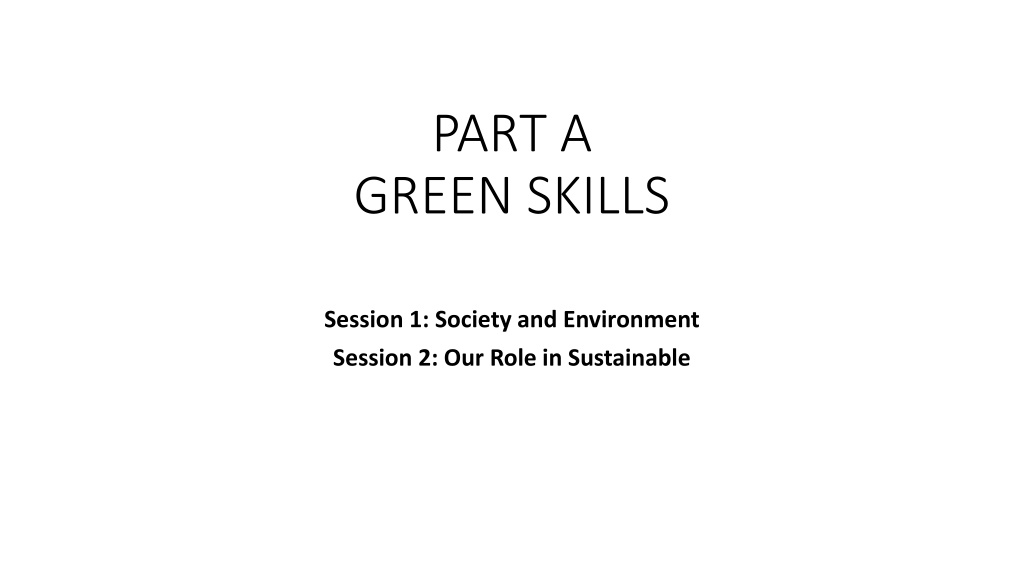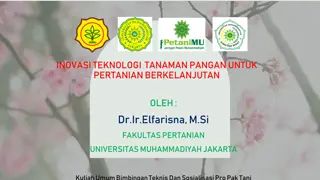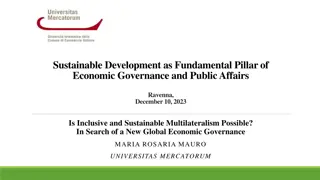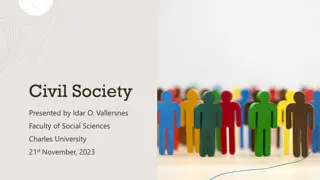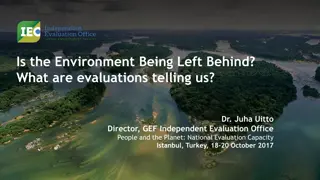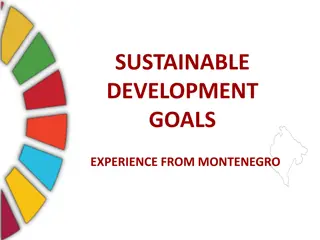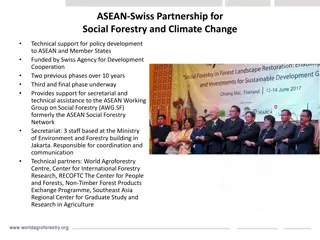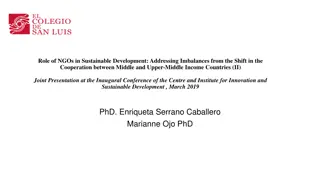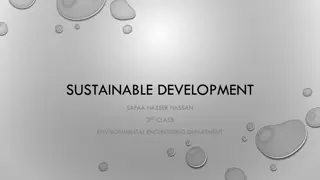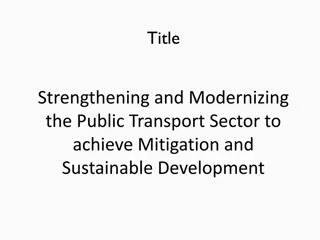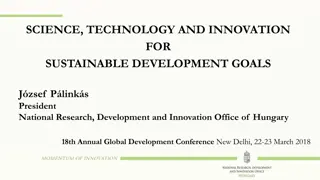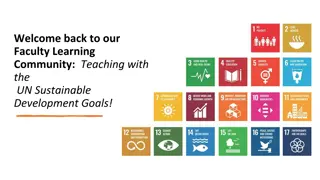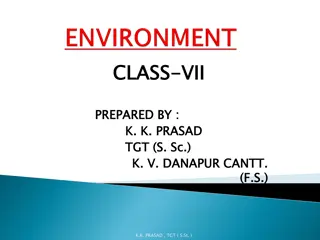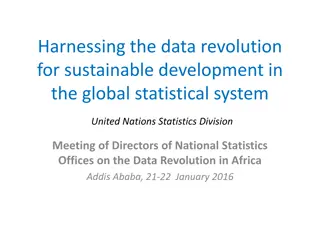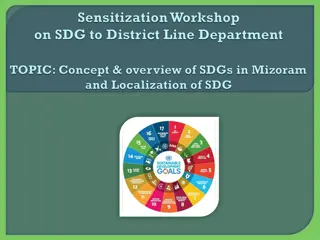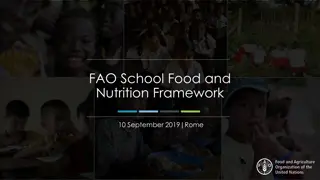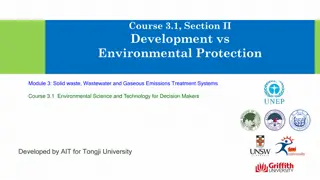Understanding Sustainable Development and Our Role in Society and Environment
Sustainable development aims to meet current needs without compromising future generations' abilities. It involves balancing economic growth, environmental care, and social well-being. Challenges include food scarcity, water pollution, and deforestation, emphasizing the importance of resource conservation and eco-friendly practices to achieve the UN's Sustainable Development Goals by 2030.
Download Presentation

Please find below an Image/Link to download the presentation.
The content on the website is provided AS IS for your information and personal use only. It may not be sold, licensed, or shared on other websites without obtaining consent from the author. Download presentation by click this link. If you encounter any issues during the download, it is possible that the publisher has removed the file from their server.
E N D
Presentation Transcript
PART A GREEN SKILLS Session 1: Society and Environment Session 2: Our Role in Sustainable
Society and Environment Society and Environment Over the years, with economic development, there has been an increase in environmental pollution. For example, with the introduction of high input agriculture, we can grow more food by using fertilisers, pesticides and hybrid crops. But it has led to soil and environmental degradation. We need to plan the use of resources in a sustainable manner so that we and our future generations can enjoy a good environment. What is Sustainable Development? Sustainable development is the development that satisfies the needs of the present without compromising the capacity of future generations, guaranteeing the balance between economic growth, care for the environment and social well-being. Importance of Sustainable Development Sustainable development is defined as development that meets the needs of the present without compromising the ability of future generations to meet their own needs (World Commission on Environment and Development, 1987). For example, sustainable agriculture consists of environment-friendly methods of farming that allow the production of agricultural crops or livestock without damage to human or natural systems. It also involves preventing the use of chemicals so as to avoid adverse effects to soil, water and biodiversity.
Problems Related to Sustainable Development Problems Related to Sustainable Development Three major problems related to sustainable development are: (a) Food: The amount of rich, fertile land needed to grow crops, such as wheat, rice, etc., is becoming less as we are using up more and more land for other purposes. Soil nutrients are also getting depleted and lots of chemicals are spoiling the soil due to use of chemical fertilisers. (b) Water: We use fresh water from rivers and ponds for drinking and cleaning but dump garbage into them. The rivers and ponds are getting polluted. This way after several years, we will have no clean water for our use. (c) Fuel: We are using a lot of wood from trees as fuels and for construction of homes and furniture. As more and more trees are being cut, it is affecting the climate of the place. Extreme weather conditions, such as floods, extreme cold or heat, are seen in many places, which affect the people living there.
Sustainable development includes reducing excessive use of resources and enhancing resource conservation; recycling and reuse of waste materials; scientific management of renewable resources, especially bio-resources; planting more trees; green grassy patches and trees to be interspersed between concrete buildings; using more environment friendly material or biodegradable material and use of technologies, which are environmental friendly and based on efficient use of resources. Sustainable Development Goals The Sustainable Development Goals (SDGs) ensure that all people enjoy peace and prosperity. The Sustainable Development Goals (SDGs) were launched at the United Nations Sustainable Development Summit in New York in September 2015, forming the 2030 Agenda for Sustainable Development. It has set targets that the countries have to should work towards and achieve by 2030. The 17 SDGs have been made with the aim to take care of important issues facing businesses, governments and society. Some of these issues are poverty, genderequality, water use, energy, climate change and biodiversity. Countries are now making policies and regulations that will promote sustainable systems needed in all economic sectors to provide a secure, affordable and sustainable economy.
Sustainable Development Initiatives When plastics were banned by the municipal corporation of Mangalore, an innovator and entrepreneur Mr Avasth Hedge found an eco-friendly alternative. He made a 100 per cent bio- degradable bag which can dissolve in hot water and decompose in natural environment. This is now being used in many countries and is going to help the environment. Another innovative idea was to stop the use of plastics spoons, forks, etc. Narayana Peesapaty made edible cutlery made out of a grain these spoons can be eaten and even if they are not eaten they will easily decompose in the soil enriching it Sustainable Processes Some practices, such as organic farming, vermi-composting and rainwater harvesting are being used to help preserve the environment. Organic farming is where farmers do not use chemical pesticides and fertilisers to increase their production. They use organic and natural fertilisers, such as cow dung to help in growing crops. This helps in better quality chemical free crops while at the same time maintaining the soil quality for future use.
Our Role in Sustainable Our Role in Sustainable Sustainable development can actually happen only when each one of us works towards it. We have to become responsible environment citizens who can protect the environment through our own efforts. Here are some basic ways in which people can help towards Sustainable Development Goals. Quality Education SDG4 Education is the most important factors for sustainable development. Children who have gone to school will be able to do jobs so that they can take care of themselves and their families. Education helps us become aware of our role as a responsible citizen. We should 1. use the facilities present in our areas. 2. take our friends to school. 3. help friends study. 4. stop friends from dropping out of school. Clean Water and Sanitation-SDG6 We must make efforts to make India free of open defecation by building toilets and creating awareness towards sanitation.
Affordable and Clean Energy-SDG 7 Using solar power i.e., power generated using the sun does not cause pollution as it does not require burning of non-renewable fuels, such as coal. We are making efforts to increase the solar power generation so that our electricity needs are met and at the same time we do not pollute the environment Decent Work and Economic Growth- SDG 8 We can (a) study and find good jobs to take care of ourselves and our families. (b) work hard and contribute to society. (c) learn and develop skills so that we get add value in our community. Reduced Inequalities SDG 10 To reduce inequalities we can 1. be helpful to one another. 2. be friendly with everyone. 3. include everyone while working or playing. 4. help others by including everyone whether they are small or big, girl or boy, belong to any class or caste..
Sustainable Cities and Communities- SDG 11 Creating Sustainable Cities 1. Save energy by switching off lights and fans when not in use. 2. Use natural light as much as possible. 3. Use energy-efficient lights (LED bulbs) and appliances. Responsible Consumers and Producers- SDG 12 We can become responsible about our own environment by 1. reusing paper, glass, plastic, water, etc. 2. taking cloth bags to market carrying fruits and vegetables. 3. donate things we do not use such as clothes, books, furniture, food, etc. 4. Buy and eat seasonal fruits and vegetables from local growers. 5. Repair leaking taps and pipes to avoid wasting water. 6. Sort and treat garbage before disposing.
Protect Life Below Water- SDG 14 Tons of plastic is found in the seas, which is killing marine life. Protecting marine life, saving our oceans from pollution is necessary to preserve the marine life. Protect Life on Land- SDG 15 Cutting of trees is leading to soil erosion and making land dry and unusable for cultivation. Planting more tree to replace the ones that we have cut is an important step towards sustainable development
